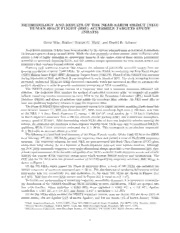
NASA Technical Reports Server (NTRS) 20110010993: Methodology and Results of the Near-Earth Object (NEO) Human Space Flight (HSF) Accessible Targets Study (NHATS) PDF
Preview NASA Technical Reports Server (NTRS) 20110010993: Methodology and Results of the Near-Earth Object (NEO) Human Space Flight (HSF) Accessible Targets Study (NHATS)
METHODOLOGY AND RESULTS OF THE NEAR-EARTH OBJECT (NEO) HUMAN SPACE FLIGHT (HSF) ACCESSIBLE TARGETS STUDY (NHATS) Brent Wm. Barbee∗, Ronald G. Mink†, and Daniel R. Adamo‡, Near-EarthAsteroids(NEAs)havebeenidentifiedbythecurrentadministrationaspotentialdestinations forhumanexplorersduringthemid-2020s. Whilethecloseproximityoftheseobjects’orbitstoEarth’sorbit creates a risk of highly damaging or catastrophic impacts, it also makes some of these objects particularly accessibletospacecraftdepartingEarth, andthispresentsuniqueopportunitiesforsolarsystemscienceand humanity’s first ventures beyond cislunar space. Planning such ambitious missions first requires the selection of potentially accessible targets from the growing population of nearly 7,800 NEAs. To accomplish this, NASA is conducting the Near-Earth Object (NEO)HumanSpaceFlight(HSF)AccessibleTargetsStudy(NHATS).PhaseIoftheNHATSwasexecuted duringSeptemberof2010,andPhaseIIwascompletedbyearlyMarchof2011. Thestudyisongoingbecause previouslyundetectedNEAsarebeingdiscoveredconstantly, whichhasmotivatedanefforttoautomatethe analysis algorithms in order to provide continuous monitoring of NEA accessibility. The NHATS analysis process consists of a trajectory filter and a minimum maximum estimated size criterion. The trajectory filter employs the method of embedded trajectory grids1 to compute all possible ballistic round-trip mission trajectories to every NEA in the Jet Propulsion Laboratory (JPL) Small-Body Database (SBDB) and stores all solutions that satisfy the trajectory filter criteria. An NEA must offer at least one qualifying trajectory solution to pass the trajectory filter. ThePhaseIINHATSfiltercriteriawerepurposelychosentobehighlyinclusive,requiringEarthdeparture date between January 1st, 2015 and December 31st, 2040, total round-trip flight time ≤ 450 days, stay time at the NEA ≥ 8 days, Earth departure C energy ≤ 60 km2/s2, total mission ∆v ≤ 12 km/s (including 3 an Earth departure maneuver from a 400 km altitude circular parking orbit), and a maximum atmospheric re-entry speed of 12 km/s. After determining which NEAs offer at least one trajectory solution meeting the criteria,theestimatedsizeconstraintisthenimposedwherebythoseNEAsmayonlybeconsideredNHATS- qualifying NEAs if their maximum estimated size is ≥ 30 m. This corresponds to an absolute magnitude H ≤ 26.5 with an assumed albedo p=0.05. Thefollowingisabriefhigh-levelsummaryofthePhaseIIstudyresults. Ofthe7,665NEAsintheSBDB as of February 3rd, 2011, 765 NEAs passed the trajectory filter and yielded a total of 79,157,604 trajectory solutions. The trajectory solutions for each NEA are post-processed into Pork Chop Contour (PCC) plots which show total mission ∆v as a function of Earth departure date and total mission duration. Although the PCC plots necessarily compress a very multi-dimensional design space into a two-dimensional plot, they permitrapidassessmentofthebreadthandqualityofanNEA’savailableEarthdepartureseasonandclearly indicate the regions of the trajectory design space which warrant further analysis and optimization. The PCC plot for the NEA with the greatest number of NHATS-qualifying trajectory solutions, 2000 SG , is 344 shown in Figure 1. Of the 765 NEAs which passed the Phase II trajectory filter, a total of 590 NEAs also satisified the further constraint of maximum estimated size ≥ 30 m. The distributions of osculating heliocentric orbital semi-major axis (a), eccentricity (e), and inclination (i), for those 590 NEAs are shown in Figures 2(a) and 2(b). Note that the semi-latus rectum used in Figure 2(a) is equal to a(cid:0)1−e2(cid:1). To further our understanding of round-trip trajectory accessibility dynamics, it is instructive to examine the distribution of the NHATS-Qualifying NEAs according to orbit classification. NEAs are grouped into four orbit families: Atiras (aphelion < 0.983 AU), Atens (aphelion > 0.983 AU, a < 1.0 AU), Apollos (perihelion < 1.017 AU, a> 1.0 AU), and Amors (1.017 < perihelion < 1.3 AU). Of the 765 NEAs which satisifed the NHATS trajectory criteria, none are Atiras, 193 are Atens (31% of known Atens), 456 are Apollos (11% of known Apollos), and 116 are Amors (4% of known Amors). While ∗FlightDynamicsEngineer,NASAGSFC,Code595,8800GreenbeltRoad,Greenbelt,MD20771,USA.MemberAIAA. †MissionSystemsEngineer,NASAGSFC,Code592,8800GreenbeltRoad,Greenbelt,MD20771,USA. ‡AstrodynamicsConsultant,4203MoonlightShadowCt.,Houston,TX77059,USA.SeniorMemberAIAA. 1 Figure 1. PCC Plot for NEA 2000 SG344 U1.5 A ms,1.4 0.45 Rectu1.3 cities 0.4 milatus1.2 Eccentri0.03.53 EASe1.1 NEA0.25 AAtpeonllsos TS-QualifyingN00..891 HATS-Qualifying0.001..512 Amors A N H N0.7 0.05 0 5 10 15 20 0 0.8 1 1.2 1.4 1.6 1.8 2 NHATS-QualifyingNEAInclinations,degrees NHATS-QualifyingNEASemimajorAxes,AU (a) Semi-latusRectumvs. Inclination (b) Eccentricityvs. Semi-majorAxis Figure 2. Distribution of the 590 NHATS-Qualifying NEAs in Osculating (a,e,i) Space Apollos comprise 60% of the NEAs which pass the NHATS trajectory filter and Atens comprise only 25%, the percentages according to orbit family are perhaps more relevant. Note that only 11% of known Apollos passed the trajectory filter while 31% of known Atens passed. These simple statistics alone strongly suggest thatAtenorbitspossessfeatureswhichtendtoenhancetheirround-triptrajectoryaccessibilityascompared to Apollos or Amors. This is significant because Atens’ orbits cause them to spend considerable time in Earth’s daytime sky, making them difficult to discover and track using ground-based observing assets. In this paper we will detail the NHATS analysis algorithms, present and analyze all NHATS results to date, and discuss aspects of HSF mission architecture design for future NEA missions. References 1Barbee, B. W., Esposito, T., Pin˜on, E. III, Hur-Diaz, S., Mink, R. G., and Adamo, D. R., “A Comprehensive Ongoing Survey of the Near-Earth Asteroid Population for Human Mission Accessibility,” Proceedings of the AIAA/AAS Guidance, Navigation, and Control Conference,Toronto,Ontario,Canada,2-5August2010,Paper2010-8368. 2
